-
 Contributors
Contributors
-
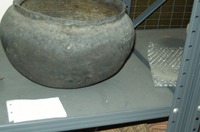 Cooking Vessel
Cooking Vessel John Wesley Powell collected this cooking vessel from the Zuni tribe in 1879. Like many of the other works he collected, he also tarnished this work by writing on it. The lack of decoration on the pot may have meant that it was more of a functional pot than a decorative one.
-
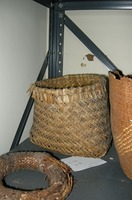 Basket
Basket This square bottomed basket from the Zuni tribe in New Mexico is in very good condition. The top of this basket is rounded and the weaving is in a zig-zag shape. This basket was likely made by a woman, as one of their roles was creating different types of storage, whether they be baskets or pottery.
-
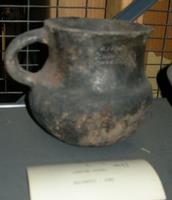 Cooking Vessel
Cooking Vessel This Zuni cooking vessel was collected by John Wesley Powell in 1879. This New Mexican tribe traditionally left the art of pottery making to the women, who learned mainly through observation. The white writing on the pot was likely an addition by Powell.
-
 Basket
Basket This square bottomed basket from the Coushatta tribe, formerly the Koasiti tribe, in Louisiana is in excellent condition. Baskets of this time were primarily used as sieves, trays, and laundry containers. These purposes are likely responsible for its stellar condition, as a lack of exposure to sunlight and the outdoors would make it more durable to signs of aging than its counterparts.
-
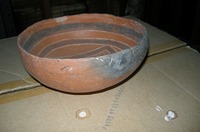 Bowl: shrine symbol
Bowl: shrine symbol This shrine symbol bowl collected by J.W. Fewkes from a ruin near Homolovi falls into the category of Hopi shrine, as the Homolovi were an ancestral group of the Hopi. The shrines were integral for maintaining the Hopi religion, as it was believed that each shrine contained an unique life essence. By having the symbols on the bowl we can infer that it was used for holding prayer offerings. The shrines were never supposed to be altered or relocated, thus making the topic of repatriation very relevant for this piece.
-
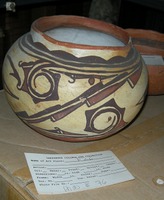 Bowl: rain cloud symbols
Bowl: rain cloud symbols The rain cloud motif on this Hopi bowl each has six corners, likely to represent the six cardinal points recognized in Hopi ceremonies. These points are North, West, South, East, Up, and Down, and are crucial to ceremonial observances. This symbolism is often used in Hopi artwork, meaning that acquiring this work was likely easier than more rare designs. The motif is especially important because of the need for water in the dry Arizona desert where the pot once resided.
-
 Owl Figurine
Owl Figurine Zuni Potters have made figurines and effigy vessels since the mid-1800s, and the motif of owls is widespread throughout. This one is likely a later version, as earlier versions showed the owls standing on their feet. The owls were less stable in such earlier depictions, and thus in later versions the feet have been eliminated. This piece has the number “400” painted across its chest, a decision that was made by collectors to label the work. In doing so, they effectively desecrated the piece.
-
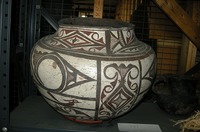 Water Jar
Water Jar The Zuni tribe is known for their rain bird motif, demonstrated on this jar. The art is more curvilinear than geometric, and the bird is symbolic of the rain that is hoped to be collected. This piece has very fine and detailed hatch marks, one of the hallmarks of a desirable Zuni pot.
-
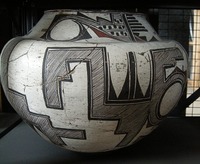 Water Jar
Water Jar Zuni potters are known for including heartline deer imagery on their pottery. This Jar is no exception, as the deer is on the lower portion of the pot. The heartline is an arrow that goes from the deer’s mouth to the stomach. It represents the breath as the life force of the animal and vaguely resembles the antlers of a deer.
-
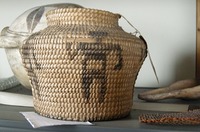 Basket
Basket This hand-woven coil basket from the Maricopa tribe in Arizona includes multiple depictions of simple human silhouettes woven through the walls of the basket. Baskets of this nature are made with a flexible coil that is spiraled out and up, with a new coil placed on top and fastened to previous coils. Each layer is stitched together until a basket is formed. This basket may have been appealing for a collector because of its authentic appearance combined with a recognizable motif to a non-Indigenous audience.
-
Ladle
-
 Ladle
Ladle Matilda Coxe Stevenson collected this black and white earthen ladle from the Zuni tribe of New Mexico. The solid symbols pictured throughout the bowl are believed to be clouds. Additionally, ladles served as intermediary vessels of varying shapes and sizes. They have been reported to aid in evenly dispersing water throughout gardens, to precisely transfer paint, and serve food.. It is likely that the symbolism present, in conjunction with the ladles use, is intended to promote precipitation that ideally will aid in the growth of the plants.
-
 Ladle
Ladle This ceramic ladle, a shashokane, was acquired by Matilda Coxe Stevenson during her time among the Zuni in current day New Mexico. The large red numbers (here, 585) served as an original identification number for Stevenson during her anthropological expeditions. Ladles served as intermediary vessels of varying shapes and sizes. They have been reported to aid in evenly dispersing water throughout gardens, to precisely transfer paint, and serve food.
-
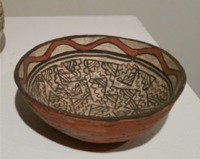 Food bowl
Food bowl This is a Zuni ceramic food bowl intricately decorated with stylistic patterns. The center interior is covered in mountains, with their bottoms meeting with rivers. The upper interior is lined with a border pattern which is understood to be translated as clear weather. In good condition,with little to no abrasions, we were able to better examine the imagery of the bowl and dissect the symbolism assigned to the piece. Based on the imagery, the meaning of the bowl is likely a design with a lighthearted, hopeful connotation, associated with a clear New Mexico landscape.
-
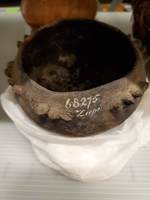 Cooking vessel
Cooking vessel This bowl is a rough ware style of pottery, made of a clay called Kuhn-kat-say. The spikes may have been used to represent the seedpods of Datura, a poisonous plant native to the Southwest. When administered in small doses, the plant causes hallucinations, perhaps purposely brought on for religious purposes.
-
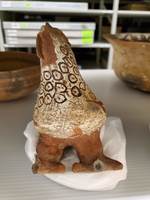 Chicken figurine
Chicken figurine This chicken effigy is a product of the Zuni tribe in New Mexico. Acquired by Matilda Coxe Stevenson, we have been able to determine it is in fact a chicken by the general shape, including its small upward tail, and dotted feathers. However, a thumb sized spout located on its back is unusual, but not unheard of among Stevenson’s other bird collections. This figurine has experienced some damages during its travels to the Smithsonian and then after being gifted to Lafayette College. Notably, the figurine is missing its outside toe on its right foot. While the damage is unfortunate, it has provided us with information, that would otherwise be challenging, or nearly impossible, to confirm, such as the use of black clay temper.
-
 Bowl: bird symbols
Bowl: bird symbols This Zuni stew bowl shows some of the unintended consequences of conservation. The adhesive, used to piece the bowl back together after it was broken, is now brittle and risks pulling slip and paint off of the body of the ceramic.
-
 Bowl
Bowl This Zuni bowl was likely used to serve stew, a communal dish. The design is geometric and patterned, including stepped designs and feather and crook designs.
-
 Basket
Basket
-
 Antelope figurine
Antelope figurine This is a ceramic rendition of a Pronghorn Antelope made by an artist from the Zuni Tribe of New Mexico. It can be identified as a Pronghorn by its signature white underbelly along with the two stripes on the throat. This figure once had horns that have since been broken off.
-
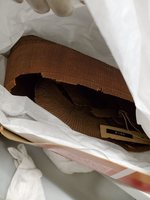 Basket
Basket This carrying basket has become extremely brittle and fragile over time. It is now difficult to hold without incurring further damage, but it would have originally been a useful tool for carrying goods.
-
 Basket
Basket This flat basket tray was woven from spruce root, with what appears to be a simple banded design for decoration. However, the reverse of the tray shows a more intricate, geometric design that has not been as affected by fading as the interior. It was collected by Mrs. L.C. Fletcher in Alaska, where it was likely sold by the artist as a means of generating income and supporting her family.
-
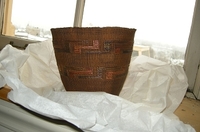 Basket
Basket According to the Sheldon Museum, baskets such as this would have been woven by women during winter months, when there was less harvesting and planting work to be done. The design is delicately woven into the basket to express the artist’s individual aesthetic sense.
-
Basket
 Contributors
Contributors  Cooking Vessel John Wesley Powell collected this cooking vessel from the Zuni tribe in 1879. Like many of the other works he collected, he also tarnished this work by writing on it. The lack of decoration on the pot may have meant that it was more of a functional pot than a decorative one.
Cooking Vessel John Wesley Powell collected this cooking vessel from the Zuni tribe in 1879. Like many of the other works he collected, he also tarnished this work by writing on it. The lack of decoration on the pot may have meant that it was more of a functional pot than a decorative one. Basket This square bottomed basket from the Zuni tribe in New Mexico is in very good condition. The top of this basket is rounded and the weaving is in a zig-zag shape. This basket was likely made by a woman, as one of their roles was creating different types of storage, whether they be baskets or pottery.
Basket This square bottomed basket from the Zuni tribe in New Mexico is in very good condition. The top of this basket is rounded and the weaving is in a zig-zag shape. This basket was likely made by a woman, as one of their roles was creating different types of storage, whether they be baskets or pottery. Cooking Vessel This Zuni cooking vessel was collected by John Wesley Powell in 1879. This New Mexican tribe traditionally left the art of pottery making to the women, who learned mainly through observation. The white writing on the pot was likely an addition by Powell.
Cooking Vessel This Zuni cooking vessel was collected by John Wesley Powell in 1879. This New Mexican tribe traditionally left the art of pottery making to the women, who learned mainly through observation. The white writing on the pot was likely an addition by Powell. Basket This square bottomed basket from the Coushatta tribe, formerly the Koasiti tribe, in Louisiana is in excellent condition. Baskets of this time were primarily used as sieves, trays, and laundry containers. These purposes are likely responsible for its stellar condition, as a lack of exposure to sunlight and the outdoors would make it more durable to signs of aging than its counterparts.
Basket This square bottomed basket from the Coushatta tribe, formerly the Koasiti tribe, in Louisiana is in excellent condition. Baskets of this time were primarily used as sieves, trays, and laundry containers. These purposes are likely responsible for its stellar condition, as a lack of exposure to sunlight and the outdoors would make it more durable to signs of aging than its counterparts. Bowl: shrine symbol This shrine symbol bowl collected by J.W. Fewkes from a ruin near Homolovi falls into the category of Hopi shrine, as the Homolovi were an ancestral group of the Hopi. The shrines were integral for maintaining the Hopi religion, as it was believed that each shrine contained an unique life essence. By having the symbols on the bowl we can infer that it was used for holding prayer offerings. The shrines were never supposed to be altered or relocated, thus making the topic of repatriation very relevant for this piece.
Bowl: shrine symbol This shrine symbol bowl collected by J.W. Fewkes from a ruin near Homolovi falls into the category of Hopi shrine, as the Homolovi were an ancestral group of the Hopi. The shrines were integral for maintaining the Hopi religion, as it was believed that each shrine contained an unique life essence. By having the symbols on the bowl we can infer that it was used for holding prayer offerings. The shrines were never supposed to be altered or relocated, thus making the topic of repatriation very relevant for this piece. Bowl: rain cloud symbols The rain cloud motif on this Hopi bowl each has six corners, likely to represent the six cardinal points recognized in Hopi ceremonies. These points are North, West, South, East, Up, and Down, and are crucial to ceremonial observances. This symbolism is often used in Hopi artwork, meaning that acquiring this work was likely easier than more rare designs. The motif is especially important because of the need for water in the dry Arizona desert where the pot once resided.
Bowl: rain cloud symbols The rain cloud motif on this Hopi bowl each has six corners, likely to represent the six cardinal points recognized in Hopi ceremonies. These points are North, West, South, East, Up, and Down, and are crucial to ceremonial observances. This symbolism is often used in Hopi artwork, meaning that acquiring this work was likely easier than more rare designs. The motif is especially important because of the need for water in the dry Arizona desert where the pot once resided. Owl Figurine Zuni Potters have made figurines and effigy vessels since the mid-1800s, and the motif of owls is widespread throughout. This one is likely a later version, as earlier versions showed the owls standing on their feet. The owls were less stable in such earlier depictions, and thus in later versions the feet have been eliminated. This piece has the number “400” painted across its chest, a decision that was made by collectors to label the work. In doing so, they effectively desecrated the piece.
Owl Figurine Zuni Potters have made figurines and effigy vessels since the mid-1800s, and the motif of owls is widespread throughout. This one is likely a later version, as earlier versions showed the owls standing on their feet. The owls were less stable in such earlier depictions, and thus in later versions the feet have been eliminated. This piece has the number “400” painted across its chest, a decision that was made by collectors to label the work. In doing so, they effectively desecrated the piece. Water Jar The Zuni tribe is known for their rain bird motif, demonstrated on this jar. The art is more curvilinear than geometric, and the bird is symbolic of the rain that is hoped to be collected. This piece has very fine and detailed hatch marks, one of the hallmarks of a desirable Zuni pot.
Water Jar The Zuni tribe is known for their rain bird motif, demonstrated on this jar. The art is more curvilinear than geometric, and the bird is symbolic of the rain that is hoped to be collected. This piece has very fine and detailed hatch marks, one of the hallmarks of a desirable Zuni pot. Water Jar Zuni potters are known for including heartline deer imagery on their pottery. This Jar is no exception, as the deer is on the lower portion of the pot. The heartline is an arrow that goes from the deer’s mouth to the stomach. It represents the breath as the life force of the animal and vaguely resembles the antlers of a deer.
Water Jar Zuni potters are known for including heartline deer imagery on their pottery. This Jar is no exception, as the deer is on the lower portion of the pot. The heartline is an arrow that goes from the deer’s mouth to the stomach. It represents the breath as the life force of the animal and vaguely resembles the antlers of a deer. Basket This hand-woven coil basket from the Maricopa tribe in Arizona includes multiple depictions of simple human silhouettes woven through the walls of the basket. Baskets of this nature are made with a flexible coil that is spiraled out and up, with a new coil placed on top and fastened to previous coils. Each layer is stitched together until a basket is formed. This basket may have been appealing for a collector because of its authentic appearance combined with a recognizable motif to a non-Indigenous audience.
Basket This hand-woven coil basket from the Maricopa tribe in Arizona includes multiple depictions of simple human silhouettes woven through the walls of the basket. Baskets of this nature are made with a flexible coil that is spiraled out and up, with a new coil placed on top and fastened to previous coils. Each layer is stitched together until a basket is formed. This basket may have been appealing for a collector because of its authentic appearance combined with a recognizable motif to a non-Indigenous audience. Ladle Matilda Coxe Stevenson collected this black and white earthen ladle from the Zuni tribe of New Mexico. The solid symbols pictured throughout the bowl are believed to be clouds. Additionally, ladles served as intermediary vessels of varying shapes and sizes. They have been reported to aid in evenly dispersing water throughout gardens, to precisely transfer paint, and serve food.. It is likely that the symbolism present, in conjunction with the ladles use, is intended to promote precipitation that ideally will aid in the growth of the plants.
Ladle Matilda Coxe Stevenson collected this black and white earthen ladle from the Zuni tribe of New Mexico. The solid symbols pictured throughout the bowl are believed to be clouds. Additionally, ladles served as intermediary vessels of varying shapes and sizes. They have been reported to aid in evenly dispersing water throughout gardens, to precisely transfer paint, and serve food.. It is likely that the symbolism present, in conjunction with the ladles use, is intended to promote precipitation that ideally will aid in the growth of the plants. Ladle This ceramic ladle, a shashokane, was acquired by Matilda Coxe Stevenson during her time among the Zuni in current day New Mexico. The large red numbers (here, 585) served as an original identification number for Stevenson during her anthropological expeditions. Ladles served as intermediary vessels of varying shapes and sizes. They have been reported to aid in evenly dispersing water throughout gardens, to precisely transfer paint, and serve food.
Ladle This ceramic ladle, a shashokane, was acquired by Matilda Coxe Stevenson during her time among the Zuni in current day New Mexico. The large red numbers (here, 585) served as an original identification number for Stevenson during her anthropological expeditions. Ladles served as intermediary vessels of varying shapes and sizes. They have been reported to aid in evenly dispersing water throughout gardens, to precisely transfer paint, and serve food. Food bowl This is a Zuni ceramic food bowl intricately decorated with stylistic patterns. The center interior is covered in mountains, with their bottoms meeting with rivers. The upper interior is lined with a border pattern which is understood to be translated as clear weather. In good condition,with little to no abrasions, we were able to better examine the imagery of the bowl and dissect the symbolism assigned to the piece. Based on the imagery, the meaning of the bowl is likely a design with a lighthearted, hopeful connotation, associated with a clear New Mexico landscape.
Food bowl This is a Zuni ceramic food bowl intricately decorated with stylistic patterns. The center interior is covered in mountains, with their bottoms meeting with rivers. The upper interior is lined with a border pattern which is understood to be translated as clear weather. In good condition,with little to no abrasions, we were able to better examine the imagery of the bowl and dissect the symbolism assigned to the piece. Based on the imagery, the meaning of the bowl is likely a design with a lighthearted, hopeful connotation, associated with a clear New Mexico landscape. Cooking vessel This bowl is a rough ware style of pottery, made of a clay called Kuhn-kat-say. The spikes may have been used to represent the seedpods of Datura, a poisonous plant native to the Southwest. When administered in small doses, the plant causes hallucinations, perhaps purposely brought on for religious purposes.
Cooking vessel This bowl is a rough ware style of pottery, made of a clay called Kuhn-kat-say. The spikes may have been used to represent the seedpods of Datura, a poisonous plant native to the Southwest. When administered in small doses, the plant causes hallucinations, perhaps purposely brought on for religious purposes. Chicken figurine This chicken effigy is a product of the Zuni tribe in New Mexico. Acquired by Matilda Coxe Stevenson, we have been able to determine it is in fact a chicken by the general shape, including its small upward tail, and dotted feathers. However, a thumb sized spout located on its back is unusual, but not unheard of among Stevenson’s other bird collections. This figurine has experienced some damages during its travels to the Smithsonian and then after being gifted to Lafayette College. Notably, the figurine is missing its outside toe on its right foot. While the damage is unfortunate, it has provided us with information, that would otherwise be challenging, or nearly impossible, to confirm, such as the use of black clay temper.
Chicken figurine This chicken effigy is a product of the Zuni tribe in New Mexico. Acquired by Matilda Coxe Stevenson, we have been able to determine it is in fact a chicken by the general shape, including its small upward tail, and dotted feathers. However, a thumb sized spout located on its back is unusual, but not unheard of among Stevenson’s other bird collections. This figurine has experienced some damages during its travels to the Smithsonian and then after being gifted to Lafayette College. Notably, the figurine is missing its outside toe on its right foot. While the damage is unfortunate, it has provided us with information, that would otherwise be challenging, or nearly impossible, to confirm, such as the use of black clay temper. Bowl: bird symbols This Zuni stew bowl shows some of the unintended consequences of conservation. The adhesive, used to piece the bowl back together after it was broken, is now brittle and risks pulling slip and paint off of the body of the ceramic.
Bowl: bird symbols This Zuni stew bowl shows some of the unintended consequences of conservation. The adhesive, used to piece the bowl back together after it was broken, is now brittle and risks pulling slip and paint off of the body of the ceramic. Bowl This Zuni bowl was likely used to serve stew, a communal dish. The design is geometric and patterned, including stepped designs and feather and crook designs.
Bowl This Zuni bowl was likely used to serve stew, a communal dish. The design is geometric and patterned, including stepped designs and feather and crook designs. Basket
Basket  Antelope figurine This is a ceramic rendition of a Pronghorn Antelope made by an artist from the Zuni Tribe of New Mexico. It can be identified as a Pronghorn by its signature white underbelly along with the two stripes on the throat. This figure once had horns that have since been broken off.
Antelope figurine This is a ceramic rendition of a Pronghorn Antelope made by an artist from the Zuni Tribe of New Mexico. It can be identified as a Pronghorn by its signature white underbelly along with the two stripes on the throat. This figure once had horns that have since been broken off. Basket This carrying basket has become extremely brittle and fragile over time. It is now difficult to hold without incurring further damage, but it would have originally been a useful tool for carrying goods.
Basket This carrying basket has become extremely brittle and fragile over time. It is now difficult to hold without incurring further damage, but it would have originally been a useful tool for carrying goods. Basket This flat basket tray was woven from spruce root, with what appears to be a simple banded design for decoration. However, the reverse of the tray shows a more intricate, geometric design that has not been as affected by fading as the interior. It was collected by Mrs. L.C. Fletcher in Alaska, where it was likely sold by the artist as a means of generating income and supporting her family.
Basket This flat basket tray was woven from spruce root, with what appears to be a simple banded design for decoration. However, the reverse of the tray shows a more intricate, geometric design that has not been as affected by fading as the interior. It was collected by Mrs. L.C. Fletcher in Alaska, where it was likely sold by the artist as a means of generating income and supporting her family. Basket According to the Sheldon Museum, baskets such as this would have been woven by women during winter months, when there was less harvesting and planting work to be done. The design is delicately woven into the basket to express the artist’s individual aesthetic sense.
Basket According to the Sheldon Museum, baskets such as this would have been woven by women during winter months, when there was less harvesting and planting work to be done. The design is delicately woven into the basket to express the artist’s individual aesthetic sense.